What pillars are needed for a chain-link mesh and how to install them?

It will not be possible to pull the mesh-netting without pillars at least a few meters. In country houses and on a summer cottage, a chain-link is the most effective and cheapest solution for fencing the adjacent territory, delimiting it from the street.

Species overview
The posts for the mesh-netting differ in the most common types of material for the supporting structure: concrete (including reinforced concrete), wood, pure metal structures and asbestos cement.

Concrete and asbestos cement are similar materials: they use a cement compound.
The consumer is primarily interested in how reliable the fence will be, how many years it will last. As the initial data - the strength of the entire fence, the relief and the perimeter of the delimited area. When, for example, it is required to enclose a plot of several tens of acres, the construction of a capital (with pouring pillars into concrete) fencing may not coincide with the owner's fast-moving plans.

Wooden
Supports made of timber or logs have been used for a long time. Wood is easy to work with and is cheap (compared to metal structures). Wooden poles are the most budgetary option. But a simple board is not good enough as a load-bearing support - even if you take the thickest one in the range, it would rather replace the chain-link than serve as its guide and fixing support. Ideal strength - by the standards of the timber supporting structure itself - is achieved with a square or round support. The beam should be strictly square in section, the log should be calibrated to a perfectly round shape.
Using a tree with a cross-section of a regular triangle, polygon will complicate the installation of the mesh.

It is easy to drive nails into a tree or screw in self-tapping screws - the mesh is suspended from them.
Without periodic maintenance of wooden poles - impregnation once a year or several years, renewal of the waterproof coating - the tree is susceptible to rotting, corroded by insects feeding on its fibers, for example, by woodcutters. If ants start in a log or a piece of timber, the owner will have to pickle the supports with chemicals. Climbing into cracks, insects nest and reproduce inside. Mold, fungi, fungus and microbes love dampness - in two or three years the piece of wood will begin to turn into dust. When replacing the posts, the chain-link in these places will be remounted.
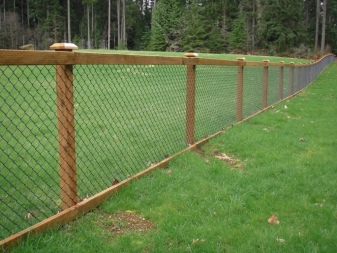

Metallic
Metal poles are much more durable than wooden ones. The most famous option is a square pipe.
As in the case of a tree, it is not recommended to use a rectangular section: the frontal and rear windage in strong winds will bend such a fence.
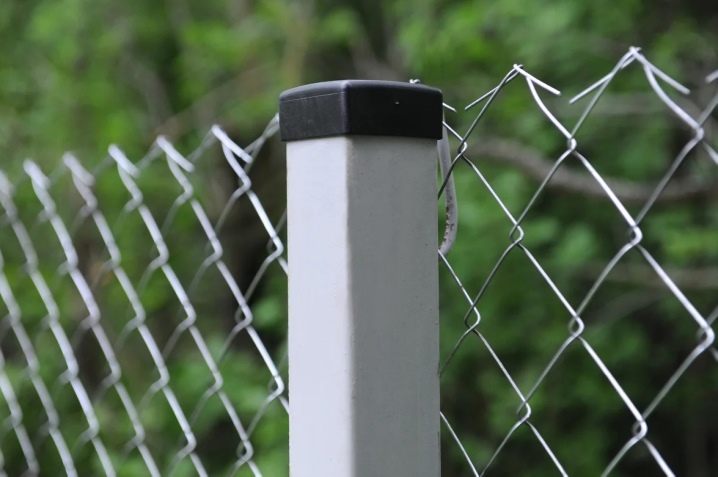
A rectangular professional pipe is used for horizontal beams that improve the fixation of the chain-link at additional attachment points. Without maintenance (periodic painting with a primer once a year or two), the pillars will stand for a maximum of ten years. An economical option is to check them for rusty spots and renew the primer where they appear, the primer should be of the same color and shade.

An equivalent alternative to a professional pipe is a simple thick-walled one. The downside is the relative high cost of construction steel. Metal cannot be dug in - it will rust and collapse in a few years. Ideal insulation from salts and soil moisture, where such a post is inserted, will be provided by the concrete pouring of the structure.

Concrete
You can also make a concrete pillar with your own hands. First, a frame of about 10x10 cm is installed, with a height of 3-3.5 m, welded from ribbed reinforcement, for example, a 16-mm section diameter. Formwork is mounted under it - so that the structure turns out to be strictly square in cross-section, for example, it comes out 15x15 cm. Concrete is poured inside in parts - approximately the same way as a "frame monolith" is cast under a multi-storey building or structure.

The disadvantage of the design is capital costs, the complexity of installing the chain-link: even before pouring with concrete, it is necessary to provide hinges, for example, from thick nails, welded into the frame on both sides. The advantage is the lack of care for the resulting reinforced concrete product. It will easily last 30 years, if not more. Does not require additional concrete casting as a base.


Asbestos-cement
Asbestos cement is inferior in durability only to high-quality reinforced concrete, for the production of concrete products for which concrete was used, prepared according to the M400 recipe or even stronger. But the cost of asbestos-cement pipes is much lower. The disadvantage is even greater difficulties with installing the mesh: if the fixing points are unsuccessfully drilled, the asbestos pipe can crack. The strength and durability of this support will be called into question.

It is recommended that they be pulled together with concrete at the base, just like steel posts.

Plastic
Plastic - low pressure polyethylene, polypropylene, polystyrene, polyurethane - cracks and fades from ultraviolet radiation, especially in the heat of summer, when the temperature is often above + 40 °. Composite materials - in particular, solid polycarbonate - are slightly better, but they will not save the fence from swaying and vibration during a hurricane. Plastic is not afraid of water, but annual temperature drops from, say, -25 ° to + 45 ° will "kill" it in a few years.
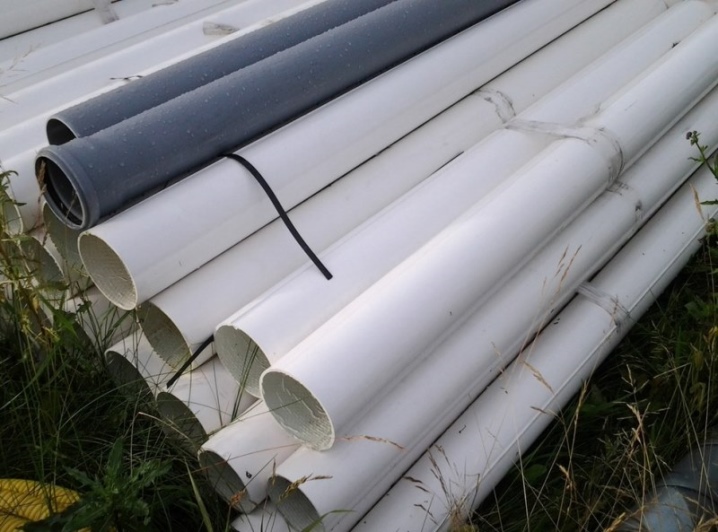
These materials are not vandal resistant: they can be easily broken off with your feet, set on fire / melted with a lighter, etc. They are only suitable as secondary, internal barriers, for example, when arranging a poultry house.

How many meters do they put
Optimal distance between supports - no more than 2 m... An attempt to save money on poles will lead to the fact that the fence will “play” from not the strongest wind, and its stability and reliability will noticeably decrease. The chain-link, due to too rare pillars, will sag faster and lose its shape, which immediately suggests that the owner of the site and living space is indifferent to the state of the fence and the house as a whole.

Quantity calculation
The area of the plot plays an important role in the calculation. For example, when you need to fence a 6-acre plot, measuring 20x30 m, do the following:
- Calculate the perimeter... In this case, the length and width of the section are added, the resulting one is multiplied by half. 100 m - the perimeter of the site. It is also the length of the chain-link in a roll (100-meter cut).
- Sample: two meters - one pillar.
In this case, we get 50 pillars.
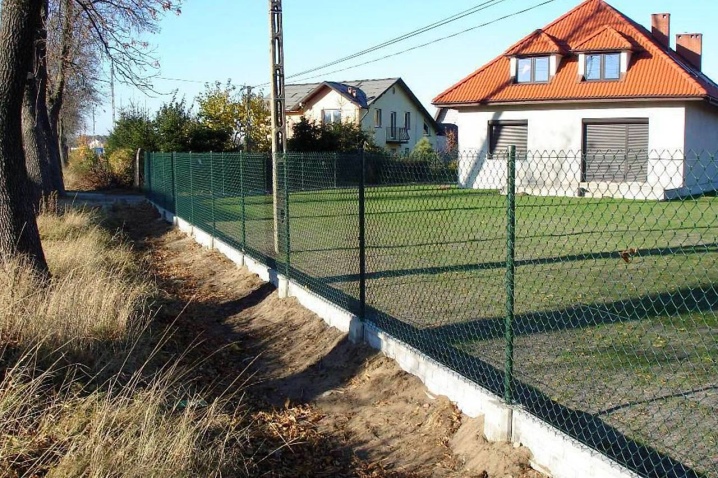
Installation
For heaving soils, for example, the pillar is concreted to a depth of 1.5 m. The aboveground part is 2 m, we get 3.5-meter sections. For a plot of 6 acres, 175 m of a round pipe or a square professional pipe with a cross section of at least 40x40 mm will be required. Before starting the installation of the pillars, the places of their installation are marked using pegs and a fishing line stretched over them. The pitch of the posts is the same throughout. To install pipes, do the following:
- Using an electric drive or walk-behind tractor - and a garden drill without a horizontal handle - dig the holes for the posts to the desired depth.
- Cut the pipe into pieces with a grinder. So, it is advisable to cut 6-meter segments brought from a metal warehouse in half into equal parts.
- Paint the professional pipe with a primer-enamel for metal... The underground part can be coated with bitumen-based paint - it protects steel from water for many years.
- Using a concrete mixer, dilute concrete of the M250 / M300 brand (this strength is sufficient for the fence base), observing the proportions of crushed stone, cement, sand and water.
- Install a layer of waterproofing (single-layer polyethylene) in the holes. It will not allow the clay and black soil surrounding the hole to mix with the surface (in relation to the soil) layers of concrete - otherwise, the strength of the screed may significantly decrease. Place fine crushed stone (crushed stone screening) at the bottom of each hole.
- Pour concrete into the holes, checking - and trimming if necessary - poles on a bubble or laser level gauge. They must be strictly vertical.
To give the concrete maximum strength after the first 6 hours from the end of its pouring - and over the next 10 days - the screed is poured with water every one to several hours. In the heat, it is recommended to do this every hour or two. In winter, at a few degrees of heat, water dries out 10 or more times slower. In a week or two, concrete will pick up the maximum amount of water and become even stronger.


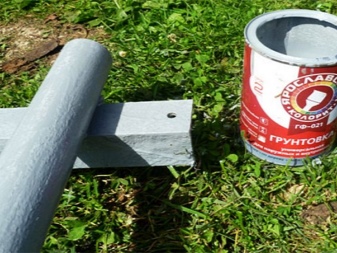

To install the chain-link, do the following:
- Stretch and fix the thick (up to 4 mm) wire along the upper and lower border of the chain-link. Thick wire is tied to the posts with a thinner one. Ideally, weld reinforcement pieces up to 10 mm along the same boundaries.
- Pull and secure the chain-link, bending its ends on a wire or reinforcement.


Horizontal beams made of rectangular steel pipes are not suitable - they are only suitable for corrugated steel, for example, galvanized roofing iron.
To install wooden poles, do the following:
- Dig holes 10 centimeters or more below the level of soil freezing. The pillars must not be buried above the lower frost heave mark.
- Underground parts of the pillars saturate with a decay and burning agent, cover with bitumen and install in the holes.
- Pour in fine gravel (screening out crushed stone) into the remaining free space of the hole and tamp it.
- Check the correct posting by level.
- Drive in nails or screw self-tapping screws into the above-ground part of the post - in the places where the chain-link is attached. This will create poles with mounting hooks.
- Stretch the chain-link and paint the posts with waterproof paint, resistant to fading in solar ultraviolet radiation.

Asbestos-cement pillars, in fact, are pipes, are concreted, like steel ones, or installed on a pre-concreted reinforcing frame of three or four longitudinal rods, reinforced with transverse sections. Reinforcement with a diameter of 12-20 mm is used, depending on the diameter of the asbotpipe and the thickness of its walls.

Correct installation of a fence made of a chain-link mesh will allow you to get a fence that is no less durable than that made from roofing iron, horizontal and vertical pipes of different sections. The chain-link mesh changes more often than the pillars themselves.

Watch a video on the topic.













The comment was sent successfully.